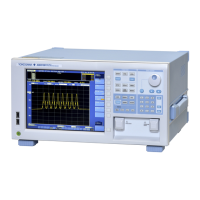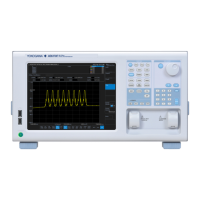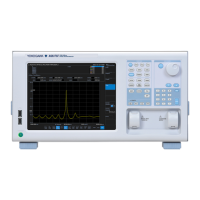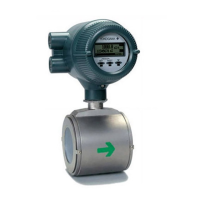App-31
IM AQ6370D-01EN
Appendix
App
Algorithm for analysis
1 Apply the WDM analysis to the signal optical waveform data of TRACE A to perform
channel detection. Note, however, that the parameter DISPLAY MASK is not used.
2 Obtain the center wavelength λi of each channel and signal optical level LIN’i of
TRACE A optical signal.
3 Obtain the output optical level LOUT’i of each channel from the output optical
waveform data of TRACE B.
4 Obtain LINi and LOUTi, which are generated by compensating OFFSET (IN,OUT) for
signal optical level and output optical level, respectively.
5 According to the setting of the parameter ASE ALGO, determine fitting area and mask
area for performing the ASE fitting.
6 Set the method for calculating the measurement resolution RBi of each channel.
• MEASURED: Determine the value of the THRESH 3dB width for each channel from
the TRACE B waveform and set to RBi.
• CAL DATA: Set the actual resolution value stored in the instrument to RBi.
7 Remove the signal optical SE elements contained in the output optical spectrum in the
following order and write the result into TRACE C.
• Obtain levels (linear) on both sides of the channel of the fitting area that was
obtained in 5.
• Use the obtained levels on both sides to obtain the provisional ASE level LB’i via
the linear interpolation.
• Obtain LBi, which is generated by compensating OFFSET (OUT) for the provisional
ASE level LB’i.
• Obtain the provisional gain G’I using the following equation.
G’i=(LOUTi − LBi)/LINi
• Multiply the TRACE A data (linear) by the provisional gain G’I and subtract the
result from the TRACE B data (linear). Then, write the result into TRACE C.
8 In the TRACE C data (linear) generated in 7, perform a fitting according to the settings
of the parameter FITTING ALGO and create the estimated ASE spectrum in TRACE
C. The data for use in the fitting is from the range of the center wavelength of each
channel ± FIT AREA to the range of MASK AREA. Obtain the level at λi in TRACE
C as the ASE level LASE’I (linear). Then, obtain LASEi, which is generated by
compensating OFFSET (OUT) for it.
Calculate gain G and NF (linear) from the following equations.
Gain G
Gi = (LOUTi − LASEi)/LINi
NF value (during the air wavelength mode)
λi
N(
)
2
2
λi
3
LASEi
1
x
x
+
(SHOT NOISE parameter: ON)
λi
N(
)
2
2
λi
3
LASEi
x
x
(SHOT NOISE parameter: OFF)
NF value (during the vacuum wavelength mode)
h x c
2
λi
3
LASEi
G G
1
x
x
+
1
(SHOT NOISE parameter: ON)
h x c
2
λi
3
LASEi
G
x
x
1
(SHOT NOISE parameter: OFF)
N(λi): Refraction index of the air
C: Speed of light in the vacuum 2.99792458 × 10
8
[m/s]
h: Planck’s constant 6.6260755 × 10
−
34
[J•s]
Perform LOG conversion for Nfi, Gi, and LASEi.
Appendix 5 Details of Optical Amplifier Analysis Function

